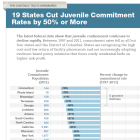
Getting Adults on Board for Alternatives to Locking Up Kids
|
The idea of hauling young offenders into court — and hoping lockup will change them — no longer appeals to a host of experts who work in the juvenile criminal justice system.
Juvenile Justice Information Exchange (https://jjie.org/page/314/)

In late September, Torri was driving down the highway with her 11-year-old son Junior in the back seat when her phone started ringing.
It was the Hamilton County Sheriff’s deputy who worked at Junior’s middle school in Chattanooga, Tennessee. Deputy Arthur Richardson asked Torri where she was. She told him she was on the way to a family birthday dinner at LongHorn Steakhouse.
“He said, ‘Is Junior with you?’” Torri recalled.
Earlier that day, Junior had been accused by other students of making a threat against the school. When Torri had come to pick him up, she’d spoken with Richardson and with administrators, who’d told her he was allowed to return to class the next day. The principal had said she would carry out an investigation then. ProPublica and WPLN are using a nickname for Junior and not including Torri’s last name at the family’s request, to prevent him from being identifiable.
When Richardson called her in the car, Torri immediately felt uneasy. He didn’t say much before hanging up, and she thought about turning around to go home. But she kept driving. When they walked into the restaurant, Torri watched as Junior happily greeted his family.
Soon her phone rang again. It was the deputy. He said he was outside in the strip mall’s parking lot and needed to talk to Junior. Torri called Junior’s stepdad, Kevin Boyer, for extra support, putting him on speaker as she went outside to talk to Richardson. She left Junior with the family, wanting to protect her son for as long as she could ...

The idea of hauling young offenders into court — and hoping lockup will change them — no longer appeals to a host of experts who work in the juvenile criminal justice system.

There is a pervasive nostalgia across this gorgeous group of photographs created by young Seattleites with Youth In Focus. They harken back to a slower time in the city’s history, before the shiny new skyline. There is an air of searching about them – as if the young artists were seeking out places they visited as children, now torn down to make way for new buildings and industry.

The New York Bureau recently compiled profiles on three young New Yorkers with one thing in common: a history of time spent in lock-down facilities.

When you bring a couple hundred good people together on a Friday in downtown Chicago, you can expect a party to break out. But if those people also happen to be juvenile justice policy wonks, the party becomes a symposium, and some work gets done. I recently attended such a party… rather symposium. The occasion for the celebration was the retirement of the founding member of Northwestern University School of Law’s Children and Family Justice Center (CFJC), Bernardine Dohrn. A separate, but obviously related reason was to celebrate CFJC’s receipt of the MacArthur Foundation’s “Creative and Effective Institutions Award.” The best way to celebrate these momentous events for this fun-loving crowd: a symposium, of course!

Explore JJIE’s coverage of adolescent brain development and how it relates to youth system involvement, substance use and families and communities.

The juvenile commitment rate in the United States dropped by 14 percent from 2010 to 2011.

The ultimate goal is to provide youth and families in high-need communities with a comprehensive community network of supports.

Some secrets are not made to be kept, especially those of brutality meted out by state institutions.